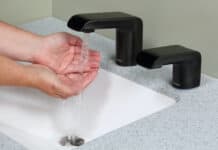In Aberdeen, SD, Tim Hofer stood in front of a production line that was turning out thousands of 3M N95 respirators. The plant was running around the clock in response to the coronavirus outbreak – and the resulting global demand for respirators. “We know what we have to do, we know we need to keep our numbers up, we know we need to keep ourselves safe, and we need to put out great quality,” said Tim, a machine operator in Aberdeen. “And that’s what we’ve come here to do.”
Like Tim, 3M employees in the United States, Asia, Europe and Latin America were on the front lines maintaining operations and producing needed supplies to help others treat and help protect people in the face of the outbreak.The company has donated personal protective equipment and medical supplies, including respirators, surgical masks and hand sanitizer, in affected areas in China, and continues to work with humanitarian aid partners such as Direct Relief and MAP International.
Facility Executive posed several questions recently with Zach Doebler, senior application engineer for 3M, to discuss what facility management teams can address in their cleaning protocols to help prevent the spread of Coronavirus and other types of viruses.
What proactive measures can facility managers take to prevent Coronavirus and other infections in facilities?
Doebler: The best preventive solution facility managers can take against an emerging pathogen (such as the 2019 Coronavirus) is to ask questions and connect with professionals in the infection prevention field in hopes of learning as much as possible about the pathogen, its symptoms, its transmission, and potential preventive solutions (vaccines to disinfectants) that may be available to combat against such pathogen.

What can facility managers learn from viruses like the Coronavirus?
Doebler: As unfortunate as outbreaks are, these can lead to improvements in a facility protocol or cleaning/disinfecting procedures which can help to better prepare the facility for future outbreaks. It is not a matter of if, but more so when a new emerging pathogen will make its way to the scene. Improvements can be related to cleaning/disinfecting procedures, review of current disinfectant chemicals used, auditing of current facility practices, and reaffirmation of proper hand hygiene and cough/sneezing best practices.
It is important for facility managers to have an emergency preparedness plan in place for these types of viruses. What should this include?
Doebler: Facility managers should conduct an internal risk assessment to determine what an emergency preparedness protocol for situations such as an outbreak should look like for their facility. During an outbreak it is highly likely that new information, in regards to the pathogen and prevention, will be coming available daily, but having a sound process to help prevent the spread and promote the cleanliness of the facility can only help to prepare the facility for such a situation.
What products can help mitigate the spread of the virus?
Doebler: The 2019 Coronavirus or now commonly known as COVID-19 is a novel pathogen and currently there is no test method or direct efficacy label claim for this pathogen on any disinfectant product label yet [as of Jan 28, 2020]. COVID-2019 has triggered the US EPA Emerging Pathogen Policy in this response. Due to the general public’s and facilities need for guidance on disinfectants to use in cases of outbreaks, this policy initiated criteria for disinfectants to meet, which allows for professional judgements on effectiveness of disinfectants with current U.S. EPA registrations with similar, representative microorganism families based on their cell structures and the microorganisms vulnerability to types of disinfectant chemistries. It is recommended for facilities to confirm with their disinfectant manufacturers to understand whether the disinfectants they use (or determine which disinfectant they may need to use) meet the U.S. EPA’s Emerging Pathogen Policy in respect for the COVID-2019 virus.
This is an evolving situation, and it is recommended that all concerned individuals consult the World Health Organization and the CDC websites frequently for the most updated information regarding the outbreak.
Want to read more on this topic?
Check out other news related to coronavirus and facility management.



















![[VIDEO] Collect Asset Data at the Speed of Walking a Building](https://facilityexecutive.com/wp-content/uploads/2024/02/maxresdefault-324x160.jpg)